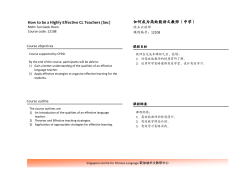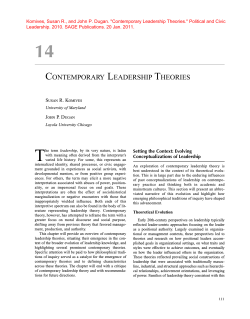
ASSIGNMENT COVER SHEET
ASSIGNMENT COVER SHEET Electronic UNIT NAME OF STUDENT (PRINT CLEARLY) STUDENT ID. NO. CODE: MAN3655 Barnard TITLE: Workplace Learning & Development Charlene 10126579 NAME OF LECTURER(s) DUE DATE Tara Smith & Jenni Parker Friday 26 August, 2011 Topic of assignment - Assignment 1 - Job Application & ePortfolio ePortfolio URL ( eg: http://jennipeportfolio.yolasite.com) so we can access YOUR e-portfolio for marking. URL = http://charlenebarnardman3655.weebly.com/ Group or tutorial (if applicable) Course Campus On-Campus ____ or Off Campus _x_ I certify that the attached assignment is my own work and that any material drawn from other sources has been acknowledged. OFFICE USE ONLY Copyright in assignments remains my property. I grant permission to the University to make copies of assignments for assessment, review and/or record keeping purposes. I note that the University reserves the right to check my assignment for plagiarism. Should the reproduction of all or part of an assignment be required by the University for any purpose other than those mentioned above, appropriate authorisation will be sought from me on the relevant form. Submitting this paper electronically as per instructions for the unit, place an ‘X’ in the box below to indicate that you have read this form and filled it in completely and that you certify as above. Please include this page in/with your submission. Any electronic responses to this submission will be sent to your ECU email address. Agreement x Date 26/08/11 PROCEDURES AND PENALTIES ON LATE ASSIGNMENTS - Refer to the University Admission, Enrolment and Academic Progress Rule 24 and the ECU Assessment Policy A student who wishes to defer the submission of an assignment must apply to the lecturer in charge of the relevant unit or course for an extension of the time within which to submit the assignment. Where an extension is sought for the submission of an assignment the application must : be in writing - preferably before the due date; and set out the grounds on which deferral is sought. ( see ECU Assessment Policy) http://intranet.ecu.edu.au/__data/assets/pdf_file/0009/20025/assign_ext.pdf Assignments submitted after the normal or extended date without approval shall incur a penalty of loss of marks. (see 39.5) ACADEMIC MISCONDUCT Rules (Students) All forms of cheating, plagiarism or collusion are regarded seriously and could result in penalties including loss of marks, exclusion from the unit or cancellation of enrolment. ---------------------------------------------------------------------------------------------------------------------- ASK Job Application Selection Criteria Response Form (Maximum 2 pages – type your responses below each criteria) Selection criteria 1: Justify the need for and importance of, learning and development to support the achievement of organisational goals. The Coca-Cola Company’s former head, Robert Woodruff philosophised “The future belongs to the discontented”; this statement is still well ingrained in the company’s beliefs as they are continually striving for excellence. As a renowned leader in being a learning organisation, the success of The Coca-Cola Company largely comes from the knowledge and experience of its employees (Franco, 2007, page1). Pemberton and Stonehouse, 2000 (cited in NathaiBalkissoon and Pun, 2011) assert that “the organisations that learn fastest and use knowledge most effectively are most likely to become and remain leaders”. One can conclude that to be successful in the current economic climate, companies need to make training a priority as competitive difference and advantage over other organisations is created by employees. With the continual change in technology it is imperative for an organisation to at least stay abreast of its competition and that requires the organisation to learn and develop its people and its systems (Nathai-Balkissoon and Pun, 2011). An example of where this has not happened is in the retail sector especially in book stores that have not stayed abreast to online competition and now face structural change throughout the organisation. For employees, training not only shows them that the company values them enough to invest in them and their development, it also a powerful motivator directly linked to job satisfaction (Stone, 2006; Nathai-Balkissoon and Pun, 2011). Through confidence in skills and abilities, staff could potentially lessen their dependence on management supervision (“Benefits of training (employee training)”, (n.d). Franco and Haase (2009) suggest that training can also save the organisation money by making more efficient workers and not having to rely on recruiting to bring in new skills. Certain types of training including ethical and diversity training and training about sexual harassment, could be used as a risk management tool that also improves the company’s image (Stone, 2006). Training provides many advantages for both the employee and the organisation and in business as in life if you do not adopt a kaizen philosophy (continually learn and growing) you run the risk of stagnating and dieing. Selection criteria 2: Compare and contrast the 4 major learning theories: (Behaviourist, Cognitivist, Humanist, Constructivist) The Behaviourist model originates from stimulus and response theory of B.F. Skinner (Hung, 2001). In this learning theory, the learner is conditioned to respond based on a stimulus and is a passive receptor to information. Behaviourism’s credibility lies in its argument that “since experiences are private it is impossible for one man to know what experiences another man is having” (Whiteley,1961, page 165). Gestalt psychologists were some of the first to criticize Behaviourism for relying on overt behaviour to explain learning and wanted the scientific community to look at patterns not isolated events (Lilienfeld, Lynn, Namy, and Woolf, 2010). Cognitive theories explain how learning and understanding is advanced through actively processing memories of information and past experiences Constructivism asserts that learning is an active process where people learn and understand things through experience and reflection. Glasersfeld (1989: 182; Cited in Paul 2006) builds on this by saying “knowledge is not passively received but actively built up by the cognizing subject". Lastly the humanistic model, similar to the social constructivist model, is largely based on the work of Abraham Maslow and Carl Rogers. The model focuses predominantly on the idea that experience is where learning begins and that people act with intention and freedom to choose one’s own behaviour as opposed to simply reacting to the environment (Lilienfeld, Lynn, Namy, and Woolf, 2010). With the key focus on self development, self-esteem, self-fulfillment, and needs are paramount. The following table explaining the key concepts of the major learning theories was taken from Hung, 2001 page 284. Table 1 Key concepts of dominant Learning theories Behaviorist Cognitivist Constructivist Social Constructivist Learning Stimulus and response Transmitting and processing of knowledge strategies Personal discovery and experimentations Mediation of different perspectives through language Type of learning Memorising and responding Memorising and application of rules Problem solving in realistic and investigative situations Collaborative learning and problem solving Instructional strategies Present for practice and feedback Plan for cognitive learning strategies Provide for active and self-regulated learner Provide for scaffolds in the learning process Key Concepts Reinforcement Reproduction and elaboration Personal discovery generally from the first principles Discovering different perspectives and shared meanings References: Benefits of training (employee training), (n.d). Retrieved from the training. com.au website: http://training.com.au/pages/menuitem9c775931afa69390f9fa5a1017a62dbc.aspx Franco, M. and Haase, H. (2009). Entrepreneurship: an organisational learning approach. Journal of Small Business and Enterprise Development (14626004), 16 (4), 628. Franco, N. (2007). Training a priority at Coca-Cola. Papua - New Guinea Post – Courier eLibrary. Web. 20 Aug. 2011 Hung, D. (2001) Theories of learning and computer-mediated instructional technologies. Edcuational Media International Singapore (1469-5790) 38(4),281. Viewed online: http://edweb.sdsu.edu/Courses/ED795A/Hung_Theories.pdf Lilienfeld, S; Lynn, S. J.; Namy, L.L. and Woolf, N. J. (2010). A framework for everyday thinking. Psychology 1: 24-28 Nathai-Balkissoon, M. and Pun, K. F. (2011). Integrating knowledge management into organisational learning. The Learning Organization (0969-6474), 18 (3), 203. Paul, E. (2006). Reflections on theories of learning. ZDM : International Reviews on Mathematical Education (1615-679X), 38 (1), 3 Stone, R. J. (2006). Managing Human Resources 2nd edition. Queensland, Australia: John Wiley & Sons Australia Ltd. Whiteley, C. H. (1961). Behaviourism. Mind (0026-4423), 70 (278), 164. Job Application Marking Guide (10%) Unsatisfactory Satisfactory Very effective Excellent Exceptional Fail Pass Credit Distinction High Distinction 0 5 6 7 8-10 Selection Criteria 1: Justify the need for and importance of, learning and development to support the achievement of organisational goals Does not justify the importance of L& D for the achievement of org. goals. Very limited justification (a very weak argument) of the importance of L& D for the achievement of org. goals. Paper is descriptive. Limited justification (a weak argument) of the importance of L& D for the achievement of org. goals. Paper is mainly descriptive. Fairly strong justification (evidence of an argument) of the importance of L& D for the achievement of org. goals. Selection Criteria demonstrates some analysis. Strong justification (a strong argument) of the importance of L& D for the achievement of org. goals. Selection Criteria demonstrates strong analysis. Selection Criteria 2: Compare and contrast the 4 major learning theories (Behaviourist, Cognitivist, Humanist, Constructivist) Not all learning theories are addressed. All learning theories are addressed, but it is mainly descriptive. All learning theories are addressed. Some aspects are compared and contrasted, but analysis is limited. All learning theories are addressed. Most aspects are compared and contrasted; there is evidence of some analysis. All learning theories are very well addressed. All aspects are compared and contrasted; there is evidence of significant analysis. Selection Criteria demonstrates very limited evidence of any academic research (textbooks only or poor journal articles). Selection Criteria demonstrates limited academic research (1 or 2 journal articles). Only the basic aspects are covered. Selection Criteria demonstrates some research (3 or 4 journal articles). Most aspects are covered. Selection Criteria demonstrates sufficient research (5 or 6 journal articles). All aspects are covered. Selection Criteria demonstrates the use of quality research articles (7+ journal articles). Justification of the importance L&D is clear. Demonstrates a depth of thought and insight into the subject. In-text and End-text contains many serious errors. Referencing is very poor, and does not follow ECU guidelines. Selection Criteria presentation is unprofessional. In-text and Endtext contains a number of serious errors. Referencing is poor, and does not follow ECU guidelines. Some aspects of the Selection Criteria are professionally presented. In-text and Endtext contains minor errors. Referencing is adequate. Not all ECU guidelines are followed. Most aspects of the Selection Criteria are professionally presented. In-text and End-text contains a few very minor errors. Referencing is good. Most ECU referencing guidelines are followed. Selection Criteria are professionally presented. In-text and End-text contains no errors. Referencing is very good. ECU referencing guidelines are followed. Selection Criteria are very professionally presented. Academic Skills ePortfolio Marking Guide (10%) Unsatisfactory Satisfactory Very effective Excellent Exceptional Fail Pass Credit Distinction High Distinction 0 5 6 7 8-10 ePortfolio – essential items included Home page - introduction Blog page – min 2 posts About Me page – bio & ECU email Job Application page – selection file attached ePortfolio Design No images or links to other resources. Text is unclear &/or has serious punctuation and spelling errors. Some images or links to other resources. Some images or links to other resources. Text lacks clarity &/or has some punctuation and spelling errors. Text is fairly clear &/or has some minor punctuation and spelling errors. Many images or links to other resources are provided that are appropriate. Text is clear, one or two very minor errors. Significant appropriate Images or links to other resources are used to enhance the eportfolio. Text is clear, exact and engaging. No errors. eJournal (blog) Personal Response to class material, activities and readings No personal response is made to the issues or concepts raised in workplace training & development Analysis demonstrates very limited evidence of personal response to the issues or concepts raised in workplace training & development Analysis conveys some evidence of personal response to the issues or concepts raised in workplace training & development Analysis conveys evidence of personal response to the issues or concepts raised. Beginning to reflect on workplace training & development in a different way. Analysis conveys extensive evidence of personal response to the issues or concepts raised. Demonstrates personal growth and workplace training & development awareness. Demonstrates an ability to reflect on most of own work. Begins to demonstrate good meta-cognition and provides examples consistently. Reflects well on all own work, demonstrates a range of meta-cognitive practices and provides many examples. Personal growth (preparation of assignments, class activities) Does not reflect on own work at all and no examples are provided. Reflects on own work improvement on occasion but limited examples are provided. Demonstrates an ability to reflect on some of own work but examples provided are minimal. Critical Reflection (thinking and linking concepts to the big picture of workplace learning & development) No reference to workplace, or outside of class learning. No reflection on new concepts. Minimal reference to workplace, or outside of class learning. Reflects on new concepts but does not demonstrate how it fits in the bigger picture. References to workplace, or outside of class learning, but does not clearly link theory with real practice. Reflects on new concepts and is beginning to link them to the bigger picture. Significant references to workplace, or outside of class learning, and is beginning to link theory with real practice. Clearly reflects on new concepts and links new concepts in the bigger picture. Significant references to workplace, or outside of class learning, and clearly links theory with real practice. Clearly reflects on new concepts and demonstrates a clear understanding of how this fits in the bigger picture Very limited discussion of your own learning and/or problem solving strategies used in MAN3655. Some discussion of your own learning and/or problem solving strategies used in MAN3655. Substantial discussion of your own learning and/or problem solving strategies used in MAN3655. Extensive, reflective discussion of your own learning and/or problem solving strategies used in MAN3655 including reference to both the technical and workplace learning and development concepts covered. Learning strategies No discussion of your own learning and/or problem solving strategies used in MAN3655.
© Copyright 2025












